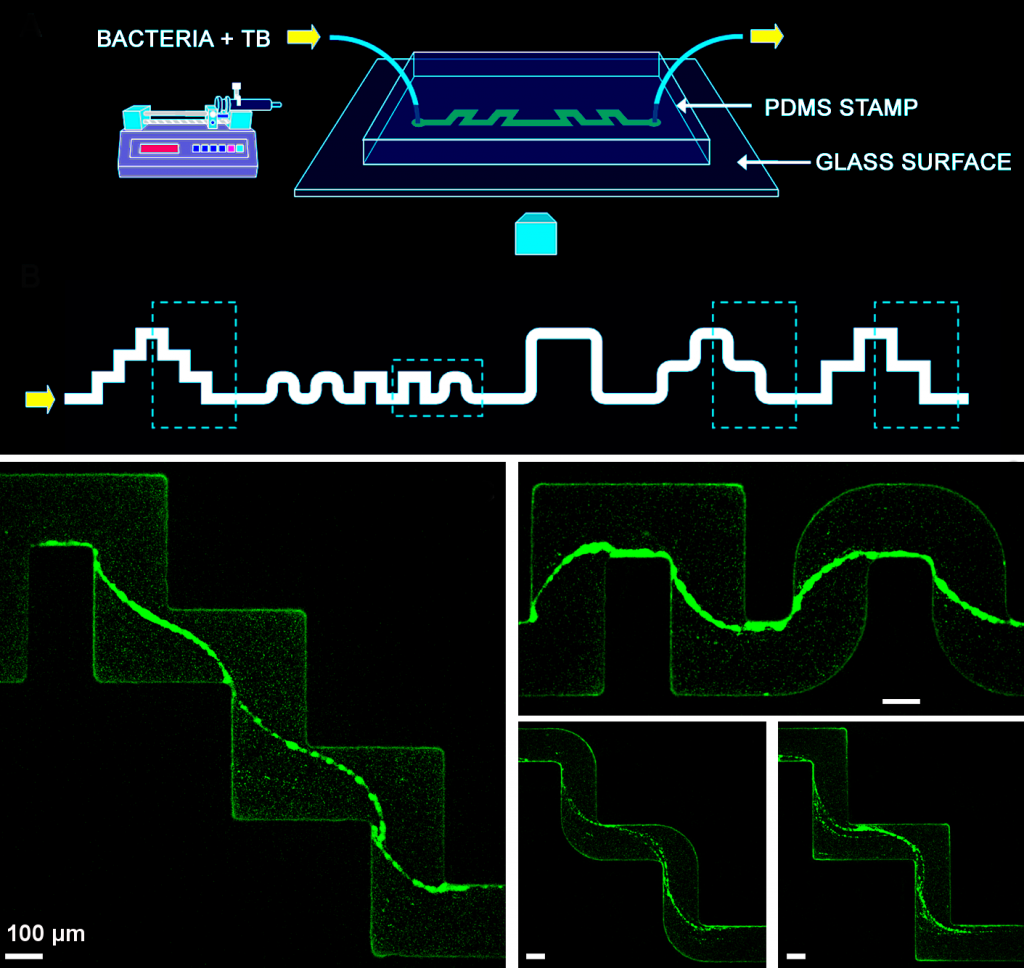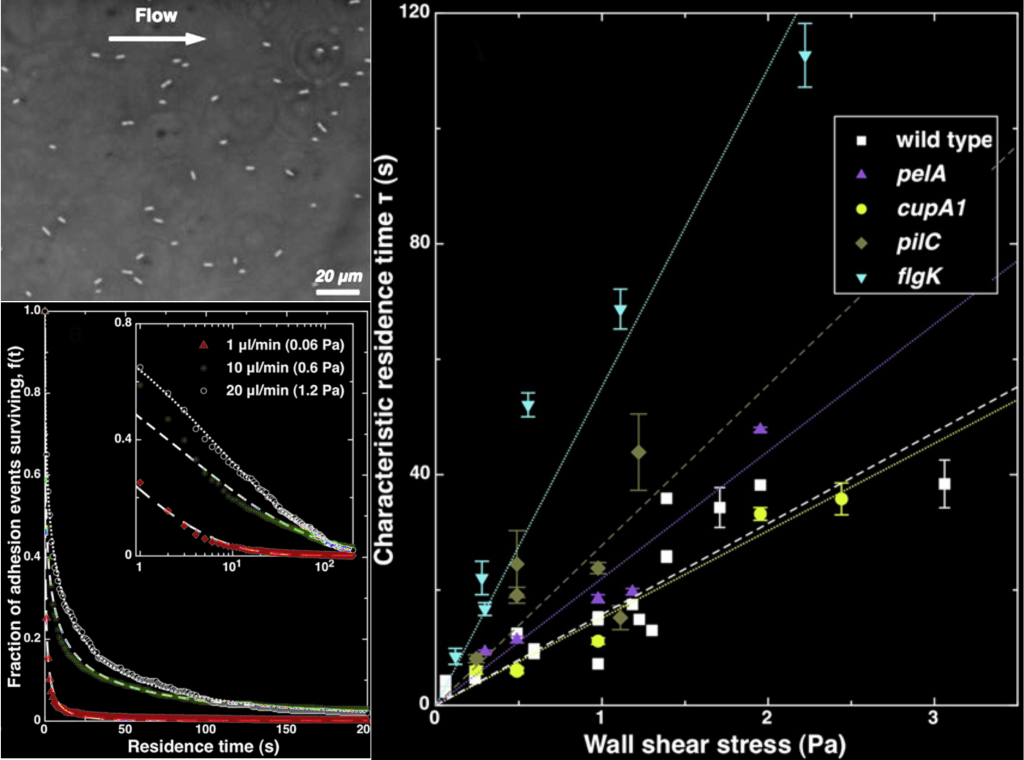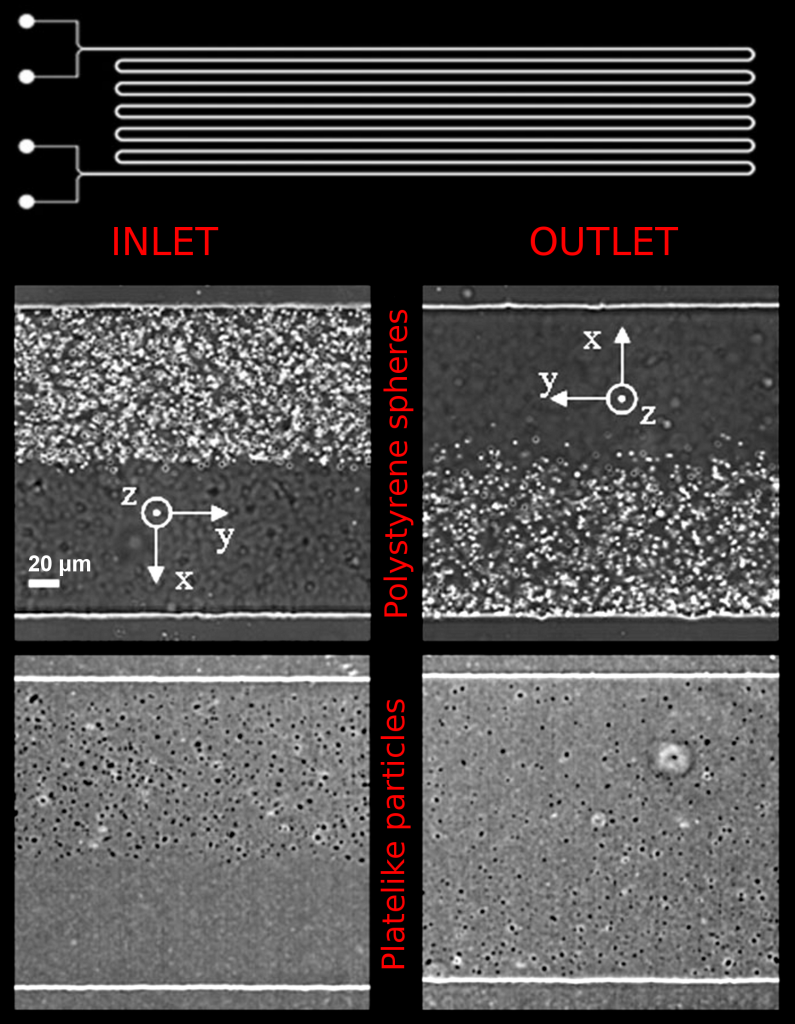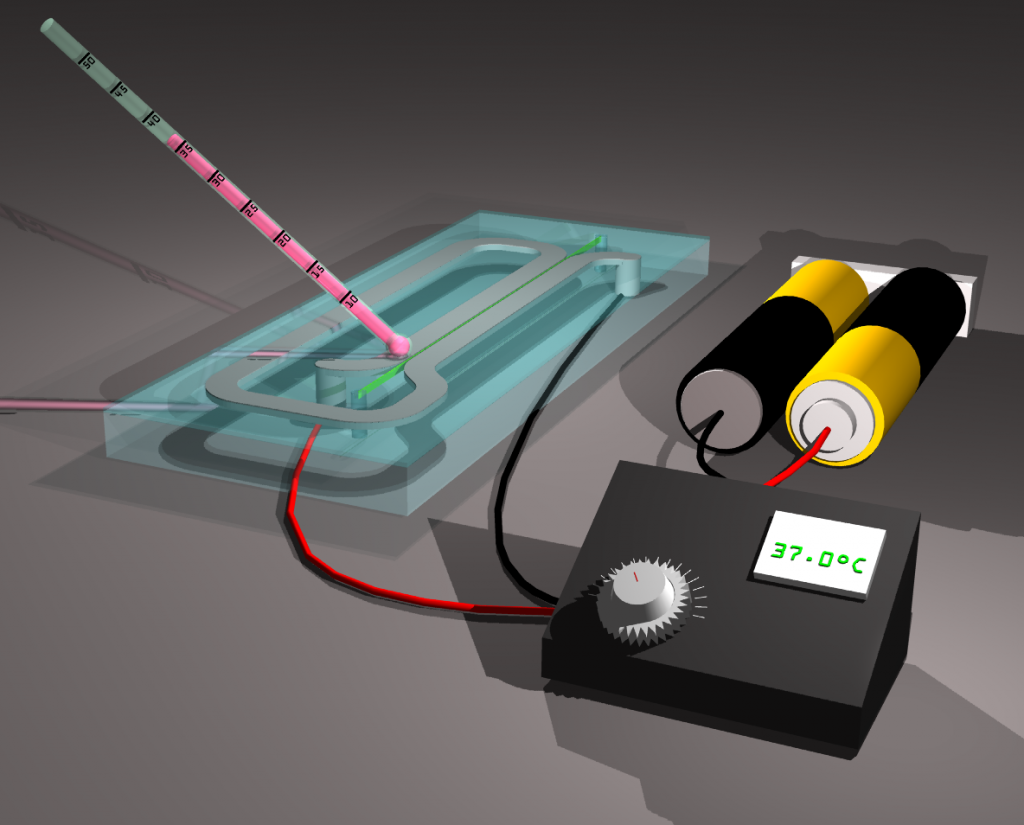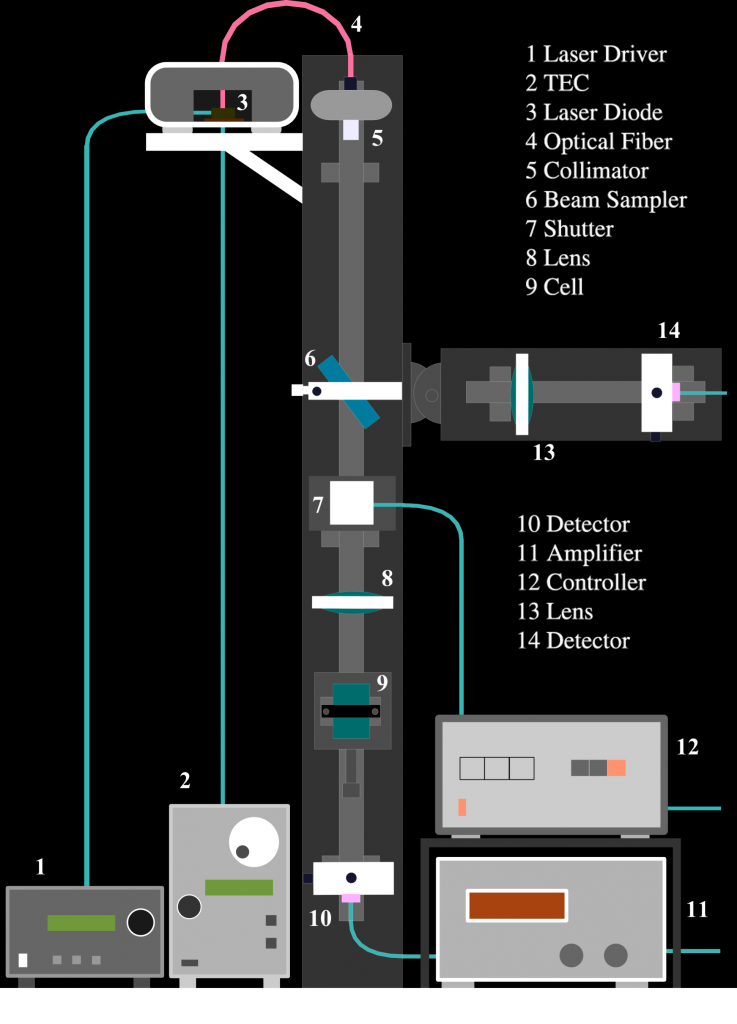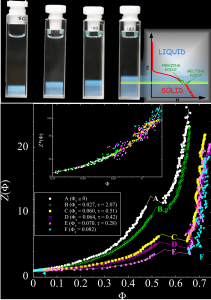Bacterial biofilms and streamers
Biofilms are microbial communities attached to a surface or an interface and encased in a self-secreted matrix of extracellular polymeric substances. Since bacterial cells within a biofilms are very difficult to eradicate and show much greater resistance to antibiotics than their planktonic counterparts, biofilms have a huge impact on medicine, industry and ecology. However, despite the fact that bacteria are often dispersed in a fluid dynamic environment, very little is known about the effect of flow on biofilm formation and development. This challenge can be efficiently addressed using microfluidics, which not only allows for better control of the physico-chemical environmental conditions and deeper characterization of the dynamics of biofilm formation, but can also reveal undiscovered links between the complex morphology of a biofilm and the flow structure. Indeed, filamentous bacterial aggregations called streamers develop in the middle horizontal plane of curved microchannels under conditions of laminar flow. Bacterial streamers are frequently observed in natural ecosystems where they play crucial roles by enhancing transport of nutrients and retention of suspended particles. Numerical simulations of the three-dimensional flow in curved microchannels highlighted the presence of a secondary vortical motion in the proximity of corners, which suggested an underlying hydrodynamic mechanism responsible for the formation of the streamers.
Laminar flow around corners triggers the formation of biofilm streamers
Secondary flow as a mechanism for the formation of biofilm streamers
Three-dimensional features in low-Reynolds-number confined corner flows
The shape of an elastic filament in a two-dimensional corner flow
Effect of shear on bacterial adhesion
Microfluidics is a powerful tool to investigate the effect of hydrodynamics on the probability of adsorption and detachment of bacteria on model surfaces. These data can be extremely useful in understanding the first steps in the development of a biofilm. Using phase-contrast microscopy in shallow straight channels, we were able to measure the time that each bacterium spends on the surface or to analyze the motility as a function of the flow rate and we discovered that shear enhances the residence time of reversibly attached bacteria. Moreover, when we applied the same type of statistical analysis to genetic mutants and different substrates, we found that shear-enhanced adhesion is a robust phenomenon regardless the presence of appendages on the cell body (such as pili or flagella) and the properties of the surface.
Shear stress increases the residence time of adhesion of Pseudomonas aeruginosa
Shear-induced diffusion
Shear-induced diffusion (SID) is a phenomenon which occurs in suspensions undergoing shear when effectively diffusive motions of the particles, due to hydrodynamic interactions between them, are much greater than Brownian diffusion. Most of the literature on SID over the past years has focused on suspensions of noncolloidal spheres, whereas experimental measurements has been mainly performed in circular Couette flow. We instead exploited the recent developments of microfluidic technologies to investigate the lateral diffusion in dilute suspensions of micron-sized nonspherical particles. In particular, we used an H-sensor, a well-established device typically adopted to make diagnostic determinations of analyte concentrations or diffusion-based extraction, to measure the transverse migration of Montmorillonite clay disk-shaped particles. Such microfluidic setup presents several advantages, as, for instance, the possibility to achieve very high and controlled shear rates and avoiding unwanted convection effects, which allow us to obtain quantitative and reproducible results over a wide range of shear rates and concentrations. The results obtained showed a remarkably large shear-induced diffusivity, about two orders of magnitude higher than experimental data and theoretical calculations for spherical particles with the same equivalent radius and particle concentration. Moreover, our data for SID scale linearly with the shear rate over a large range (from 50 to 5000 s-1) and, at very low concentration, show a simple proportionality to the volume fraction, which means irreversible interactions, plus a higher-order dependence on the square of particle concentration. These data are in good agreement with previous experimental and theoretical results for spheres when rescaled with the particle number density.
Shear-Induced Diffusion of Platelike Particles in Microchannels
Temperature control and thermophoretic separation in microfluidic devices
A new technique to control temperature along microchannels using a low viscosity, conductive epoxy as Joule heater was developed. By using this technique we were able to effectively keep a constant temperature or create a temperature gradient across a microfluidic channel. In the latter case we used thermophoresis (i.e., particle motion driven by a temperature gradient) to separate colloidal particles suspended in aqueous solution in a microfluidic lab-on-chip system.
A portable device for temperature control along microchannels
Thermophoresis: microfluidics characterization and separation
Thermal lens apparatus for particle thermophoresis
Thermophoresis (also known as Soret effect) is particle motion driven by a temperature gradient. It plays a crucial role in naturally occurring processes such as in the Earth’s mantle convective motions or in the thermohaline circulation in the oceans, as well as in industrial applications. Although well-known, this phenomenon is still very little understood, especially in the less studied case of aqueous solutions. Accurate measurements of thermophoresis can be performed using the so-called “thermal lens” (TL) method. Thermal lens is a phenomenon that occurs when a focused laser beam heats up a partially absorbing medium, generating a locally inhomogeneous temperature profile. Thermal expansion then induces a density distribution in the sample that has a simple parabolic shape near the beam center. Such a radial density profile produces likewise a quadratic refractive index profile, acting as a negative lens. In fluid mixtures or colloidal dispersions, owing to thermal diffusion, the temperature profile induces a concentration profile, leading to an additional lensing effect. Owing to the different order of magnitudes of thermal diffusivity and mass diffusion, these two lensing effects take place on separated time scales, allowing for a precise measurement of the induced concentration gradient, and therefore of the Soret coefficient. The main advantage of TL comparing with classical methods resides in the much smaller spatial scale on which mass diffusion occurs allowing for very fast measurements. Moreover, the experimental setup developed is specifically designed for working with aqueous solutions, which are systems of foremost interest and, at variance with other optical techniques so far, this method does not perturb the sample by calling for the addition of any light-absorbing molecule.
Thermal-lensing measurement of particle thermophoresis in aqueous dispersions
Thermal properties of nanofluids
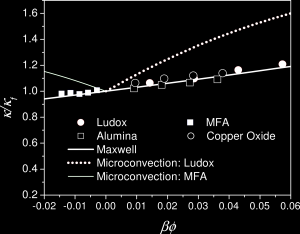 Nanofluids refers to metal (or oxide metal) nanoparticle suspensions, for which some experimental works in the last few years have shown that the increase in thermal conductivity with increasing nanoparticles volume fraction can be significantly larger than theoretical predictions. I have shown that the thermal lens method can be profitably used to measure the thermal properties of nanofluids. Moreover, the collected data, together with transient hot-wire measurements on the same samples, found a very good agreement with Maxwell’s mean field theory.
Nanofluids refers to metal (or oxide metal) nanoparticle suspensions, for which some experimental works in the last few years have shown that the increase in thermal conductivity with increasing nanoparticles volume fraction can be significantly larger than theoretical predictions. I have shown that the thermal lens method can be profitably used to measure the thermal properties of nanofluids. Moreover, the collected data, together with transient hot-wire measurements on the same samples, found a very good agreement with Maxwell’s mean field theory.
Optical measurements of the thermal properties of nanofluids
Numerical Analysis of Convective Instabilities in a Transient Short-Hot-Wire Setup for Measurement of Liquid Thermal Conductivity
Mean-Field Versus Microconvection Effects in Nanofluid Thermal Conduction
The Classical Nature of Thermal Conduction in Nanofluids
Sedimentation and depletion effects in colloidal suspensions
Brownian particles settle under the action of the Earth’s gravitational field. Important information about particle size and interactions can be obtained from the migration velocity and the final equilibrium distribution, where the sedimentation flux is balanced by diffusion, which directly yields the osmotic equation of state. In practice, however, it is difficult to measure particle number densities accurately over the required wide concentration range. Using optically anisotropic particles (PFA) it is possible to exploit the presence of a strong depolarized component in the scattered intensity which is strictly proportional to the particle number density and totally insensible to interparticle interactions. This apparatus allowed us to study highly concentrated samples, such as colloidal crystals or gels. Moreover, for dilute samples, sedimentation profiles can be measured both from the polarized scattered light and from the deflection of the transmitted beam by using a precision position detector.
Sticky Hard Spheres: Equation of State, Phase Diagram, and Metastable Gels
Kinetics of sedimentation in colloidal suspensions

